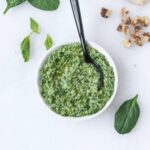When it comes to baby feeding and baby's development in general, the pincer grasp is a fun and important milestone. Here is what you need to know about the pincer grasp and how it relates to baby led weaning.

If you've been reading about baby led weaning or child development, you may see the "pincer grasp" referred to. I will often refer to it on this blog when explaining how to serve meals to babies based on the individual baby's development. To help deepen your understanding of this developmental milestone, I'll explain what the pincer grasp is, how and when it develops, and what it tells you about baby led weaning with your little one.
Jump to:
What is the Pincer Grasp?
First thing first: what is the pincer grasp? The pincer grasp is using the index finger and thumb to pick up or hold an object. It is a milestone in your baby's fine motor development that uses skills such as hand-eye coordination, and strength, especially in controlling the small muscles of the hand.
At What Age Does the Pincer Grasp Develop?
While every baby's developmental timeline is different, you can expect your baby to develop a pincer grasp anywhere from 8 to 11 months of age.
Stages of Baby's Grasp Development

Babies develop the motor skills of grasping objects in stages. You may notice this change over time, especially with baby led weaning as you watch your baby pick up food and bring it to his mouth over in different ways.
- Palmar grasp: Baby brings fingers in toward the palm, curling fingers around an object - think baby wrapping a tiny hand around your finger.
- Raking: Baby uses the fingers other than the thumb like a rake, curling the top of the fingers over the object to bring items toward him.
- Early or inferior pincer grasp: Baby uses the pads of the index finger and thumb to pick up small objects. This is the precursor to pincer grasp development.
- Pincer grasp: Baby uses the tips of the index finger and thumb to pick up small objects. This is the "true" or "superior" pincer grasp that requires practice and coordination.
Pincer Grasp Activities
It is likely that your baby will develop this grasp on his own by exploring and practicing everyday activities. This is one of the great benefits of baby led weaning - baby gets to practice developing this and other fine motor skills at every meal and will likely catch on more quickly! However, if you'd like to give your little one some practice, here a few simple activities you can do:
- Let baby self-feed! Place small pieces of appropriately-textured (soft) foods in front of baby and watch as he reaches for them and picks them up to eat. You may notice any of the stages of grasping mentioned above.
- Play! Place a few different sized small objects in front of baby for him to explore and pick up, including balls, toys, buttons, blocks, or coins. Make sure to supervise closely to avoid choking, since babies at this age put everything in their mouths!
- Encourage the use of objects such as crayons, a soft spoon, fork, or other utensil. Even though baby won't understand the use, just playing and grasping will help develop coordination of the small muscles in the hands.
If your baby still isn't showing signs of pincer grasp development around 12 months, your doctor may recommend that you visit an occupational therapist.
How To Prepare Food For Babies with the Pincer Grasp

So how does this all relate to baby led weaning? Rest assured, you don't have to know all of the information I just shared with you. What you really need to know is that the type of grasp your baby uses will determine the shape of food you serve for baby led weaning. Before baby has developed a pincer grasp, you will serve appropriate foods in long, finger-shaped pieces so that baby can hold onto them with a palmar or raking grasp and still have some of the food poking out from his fist to nibble on. After baby has developed the pincer grasp, you can cut food into small pieces, about the size of your fingernail, so that baby can pick up the individual pieces and pop them into his mouth.
It doesn't have to be 100% cut-and-dry, as some foods, such as a chicken leg, you can continue to offer in large pieces, while others, like peas, will always be offered small. A variety of shapes and sizes is always important as babies grow older to help them practice coordination!


















Leave a Reply